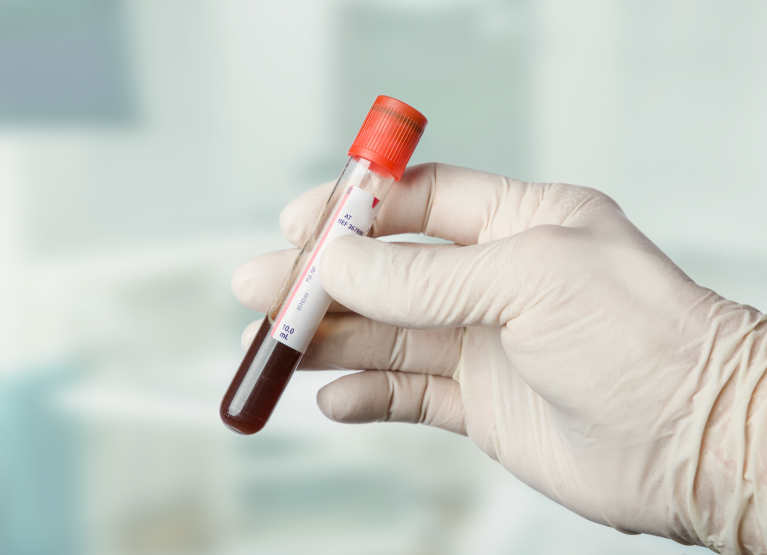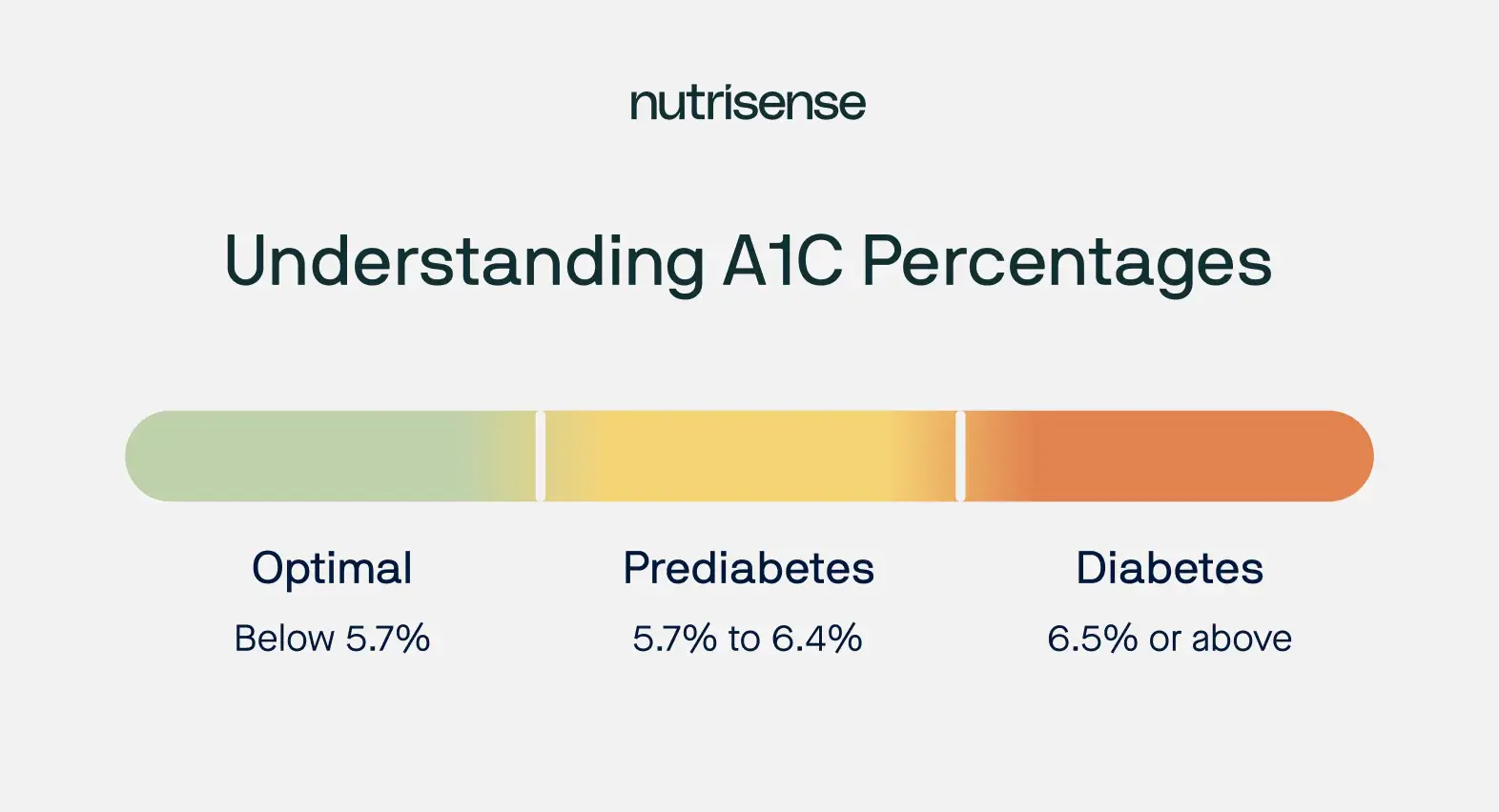What Should My A1C Goal Be?

Key Takeways
Whether you're noticing symptoms of more frequent blood sugar spikes (like increased thirst, fatigue, or blurred vision) or simply want to learn more about your glucose, understanding optimal A1C levels is a good idea. You'll learn more about what this key diagnostic marker is and what affects these levels so you can make better choices for your metabolic health—and improve blood sugar control while you're at it.
In this article, we'll review what the A1C test measures, who these tests may benefit, and how you can set goals for improving your A1C level.
The A1C Test: What is it?
An A1C test measures the percentage of red blood cells with sugar-coated hemoglobin. Since it measures average value over three months, it can help uncover trends in your overall glucose levels.
HbA1C is a medical term for glycated or glycosylated hemoglobin, a protein found within red blood cells. Glycated hemoglobin refers to the hemoglobin attached to glucose.
The lifecycle of red blood cells spans from about 8 weeks to 12 weeks, so the A1C levels in your blood samples reflect your blood glucose levels over the past three months.
Why Should I Get the A1C Test?

Measuring glycated hemoglobin through the A1C test is a valuable tool in understanding the bigger picture when it comes to your body's glycemic control. Because red blood cells live for up to three months, the A1C test can provide helpful insight into the bigger picture of your body's average blood glucose level and metabolic health.
The finger-prick method of testing your blood sugar captures a snapshot of your average blood sugar level in your blood vessels at that exact moment. On the other hand, the A1C test estimates a two to three-month average of your blood glucose values.
While finger-prick blood tests may shed light on how your blood glucose levels fluctuate when you skip breakfast, for example, they won't provide much insight into your overall glucose trends.
A useful tool that could help is a biosensor called a continuous glucose monitor (CGM), which enables real-time tracking of glucose levels over extended periods. It can capture fluctuations not detected by the A1C and point out trends that a finger stick may overlook.
Diabetes Symptoms You Shouldn't Ignore
If you haven't received a prediabetes or diabetes diagnosis, it might be wise to take a proactive stance by undergoing an A1C test when you experience these symptoms:
- Blurry vision
- Frequent need to urinate
- Increased thirst and hunger
- Fatigue or weakness
- Sudden weight loss
- Shakiness or irritability
- Numbness or tingling in hands or feet
Certain risk factors, such as family history, obesity, heart disease, and a sedentary lifestyle, may also increase your chances of developing diabetes.
However, it's important to note that anyone can develop diabetes regardless of their risk factors. So, if you experience any of these symptoms, it's a good idea to talk to your doctor and get tested.
Ignoring these symptoms and dealing with persistent hyperglycemia (high blood glucose levels) could increase your chances of developing type 2 diabetes mellitus. It may also lead to complications like chronic kidney disease, heart issues, nerve damage, microvascular complications, and vision loss. Your quality of life and life expectancy could also suffer as a result of untreated diabetes or poor diabetes control.
On the other hand, you can also suffer from severe hypoglycemia (low blood glucose levels) if you ignore symptoms and let your blood glucose levels drop below average levels. This may lead to potential emergencies such as seizures, loss of consciousness, and heart failure.
Diagnosing Prediabetes and Type 2 Diabetes With the A1C Test
HbA1C levels are used as a diagnostic tool for diagnosing people with type 2 diabetes, gestational diabetes, and prediabetes. The A1C test is generally the preferred method of screening for and diagnosing diabetes for several reasons, including:
- It doesn't involve special instructions or requirements (such as fasting).
- It can be done at any time of the day.
- It's considered more convenient than oral glucose tolerance and fasting plasma glucose tests.
The A1C test can also have a nearly identical sensitivity for predicting diabetic retinopathy. This means the test can be a valuable tool and effective in "picking up" how likely someone may develop diabetes-induced retinopathy.
It's interesting to note that in some cases, the A1C test can detect glucose levels corresponding to prediabetes and diabetes, while the fasting blood glucose test doesn't, and vice versa.
Using A1C for Elevated Blood Glucose Levels

If your A1C is elevated, you'll want to work with your doctor or a medical professional to set an A1C healthy range goal based on your individual health needs. Your doctor may specify certain glycemic goals based on your current levels and advise certain lifestyle changes that may help lower your A1C value over time.
Many lifestyle and dietary changes can take time to improve blood glucose levels. As you work towards your goals, you may want to ensure you regularly monitor your A1C.
Certain medications for diabetic glycemic control have been observed to take effect in less time for some people with diabetes. Remember, lifestyle interventions are important to incorporate in your health plan alongside any medications. If you have elevated A1C levels, you may want to discuss your options with a medical professional to determine what’s best for your health.
Even if you don't have high A1C levels, monitoring and managing your blood glucose levels can have many benefits. Glucose imbalances can also open the door to other health conditions, such as cardiovascular diseases, fatty liver, liver diseases, kidney disease, heart attack, and more.
Limitations of A1C
It's also a good idea to understand the limitations of the A1C test. For example, some conditions, such as anemia, can alter the turnover of red blood cells, leading to more glucose exposure and higher A1C levels as a result.
Other factors, such as certain diabetes medications, medical conditions, high alcohol consumption, or even blood transfusions, have all been observed to falsely elevate A1C levels in some cases. Conversely, factors such as pregnancy, vitamin C, or vitamin E ingestion have been observed to cause falsely decreased A1C levels reflected in tests.
If you're concerned about your A1C levels, consider pairing this test with other forms of glucose measuring and discussing your results with your doctor.
What are the Updated Guidelines for A1C?

According to the ADA, a diabetes diagnosis can be made if HbA1C levels are 6.5 percent or higher. Ranges between 5.7 and 6.4 percent are considered high risk for diabetes. People who have HbA1c levels between 6 and 6.5 percent are considered at an even higher risk of diabetes and severe hyperglycemia episodes. In these cases, healthcare professionals will most likely advise you to undergo other forms of testing.
An A1C level below 5.7 percent is considered normal. Some practitioners may set an "optimal range." However, there isn't strong evidence to support any one range as being optimal at the present time.
This is because the A1C test may be prone to certain inaccuracies. Various factors, including chronic blood loss or more serious conditions, such as splenomegaly, may lead to misinterpretation of this test. This may be one reason why other blood draw tests can be more effective in diagnosing diabetes.
For example, some research has suggested that HbA1C levels between 6.0 and 6.5 percent may have a relatively higher rate of false positive or false negative readings and should be combined with other lab values, such as a fasting glucose reading, for a full assessment.
A1C Target: What Should my A1C Goals be?
Your A1C goals will depend on your current A1C levels, lifestyle, and nutritional habits. You and your healthcare providers typically discuss these factors to determine a realistic goal. Setting these goals will also help you determine a realistic timeline to reduce your A1C levels.
Ideally, your goal may be to bring your A1C levels within the normal range and ultimately work towards keeping it between 5 to 5.4 percent.
Understanding A1C Percentages

Your A1C is calculated using the following formulas:
- As a percentage: A1C = (Estimated average glucose (mg/dL) + 46.7) / 28.7
- As a measurement of mmol/mol: A1C = 10.929 * (A1C (%) - 2.15)
Want to avoid getting into the calculation yourself? Check out our A1C calculator here.
A1C Goals for Those Without Diabetes
If you're in the very high-risk group for developing diabetes (A1C levels between 6 to 6.5 percent), your initial goal may be to reduce your A1C enough to fall outside of the prediabetes threshold. The target range in this case is between 5.7 percent to 6.4 percent.
For those around the upper limit between 5.5 to 5.7 percent, aim to gradually lower your levels to the optimal range of 5.4 percent or lower.
A1C Goals for Those with Diabetes
The American Diabetes Association (ADA) recommends that people with diabetes aim for an A1C level of less than 7 percent. If you've been diagnosed with type 2 diabetes, you should work with your diabetes care team to implement healthy lifestyle habits that may help your blood sugar response.
Below, we'll take you through some evidence-backed tips that may help lower your A1C.
How can I get my A1C down quickly?

In general, there's no quick fix when it comes to lowering your A1C levels. Often, the most sustainable way to achieve normal HbA1C levels is to incorporate a variety of effective lifestyle habits, dietary changes, and, in some cases, medications.
Lifestyle habits that can help optimize your blood glucose levels include:
- Walking after eating
- Getting high-quality sleep
- Reducing stress
- Getting appropriate amounts of exercise
- Tracking blood glucose with a continuous blood glucose monitor
Dietary changes that can help optimize your blood glucose levels include:
- Incorporating more fiber (different types of fiber have different health benefits)
- Including healthy fats
- Figuring out the correct macronutrient ratio for you
- Staying hydrated throughout the day
- Eating adequate protein
Remember, lasting change takes time! It may take several weeks to months for all of this to reflect in your A1C levels.
Find the right Nutrisense programto turn insight into progress.
Understand Your A1C Levels with Nutrisense
Knowing you have elevated A1C levels can be a stressful experience. However, with the help of expert support, you no longer have to constantly worry about sorting through all the information yourself to figure out how to get them under control!
From access to 1:1 video calls, to community support and real-time data insights into your unique body, signing up for the Nutrisense program is a great way to demystify confusing health metrics and learn what works for you. Our credentialed nutritionists and dietitians can fill in the gaps where traditional healthcare may not be able to, so you can take control of your health.
We provide tailored data analysis, real-time insights into your body's glucose data from a continuous glucose monitor, and lifestyle and nutritional advice to help you achieve your health goals.
By continuously optimizing your blood sugar levels, the risk of hypoglycemia and hyperglycemia complications decreases as your overall metabolic health improves. Additionally, you will better understand how different foods and activities affect your blood glucose levels, allowing you to make more informed decisions about your daily habits.
Take our quiz to find the right fit for your needs!
Go Beyond Glucose Data with Nutrisense
Your glucose can significantly impact how your body feels and functions. That’s why stable levels are an important factor in supporting overall wellbeing. But viewing glucose isn't enough. Nutrisense, you’ll be able to learn how to use your body's data to make informed lifestyle choices that support healthy living.
One-to-one coaching
Sign up to access insurance-covered video calls to work with a glucose expert: a personal registered dietitian or certified nutritionist who will help tailor your lifestyle and diet to your goals.
Monitor and measure what matters
With the Nutrisense CGM Program, you can monitor your glucose with health tech like glucose biosensors and continuous glucose monitor (CGM)s, and analyze the trends over time with the Nutrisense App. This will help you make the most informed choices about the foods you consume and their impact on your health.
Find your best fit
Ready to take the first step? Start with our quiz to find the right Nutrisense program to help you take control.

Heather is a Registered and Licensed Dietitian Nutritionist (RDN, LDN), subject matter expert, and technical writer, with a master's degree in nutrition science from Bastyr University. She has a specialty in neuroendocrinology and has been working in the field of nutrition—including nutrition research, education, medical writing, and clinical integrative and functional nutrition—for over 15 years.




